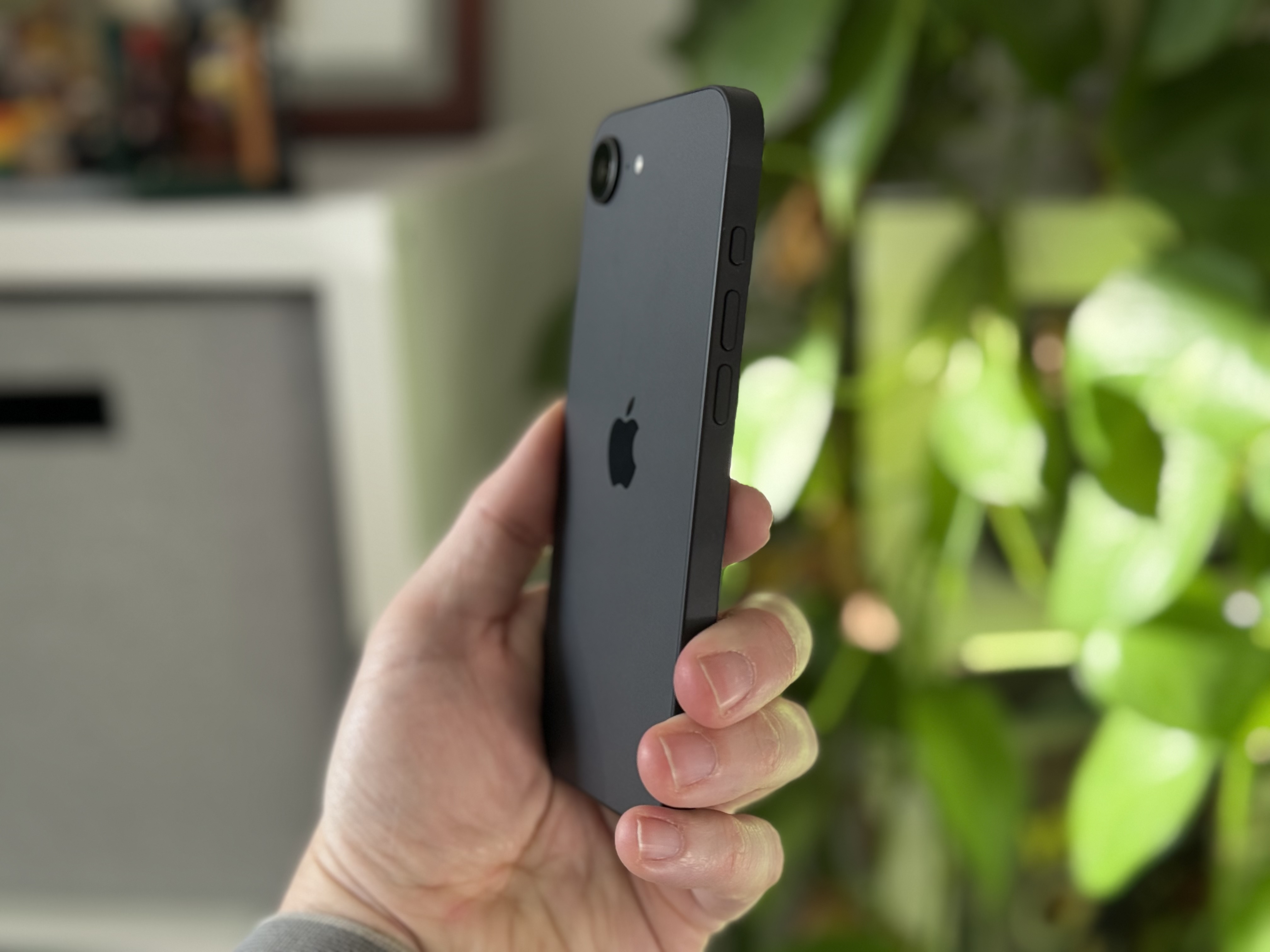Laptop Mag Verdict
The 13-inch MacBook Pro with Touch Bar delivers even faster performance and a slightly better keyboard, but the battery life could be better.
Pros
- +
Blazing-fast performance
- +
Bright and colorful Retina display
- +
Slightly improved keyboard
- +
Great speakers
- +
Helpful Touch ID button
Cons
- -
Thick bezels
- -
Heavier than other 13-inch laptops
- -
Battery life could be longer
- -
Pricey
Why you can trust Laptop Mag
Editor's Note 7.19.21: Laptop Mag doesn't generally recommend laptops two years or older. If you're in the market for a new MacBook, please check out our reviews on the MacBook Pro 2020 (13-inch) and Apple MacBook Pro (13-inch, M1, 2020).
It's a stretch to call the 13-inch MacBook Pro with Touch Bar new for 2019. That's because it's mostly just a spec upgrade -- with one important exception. Now featuring faster quad-core processors, the 13-inch MacBook Pro (starting at $1,799, or $1,999 as tested) offers more speed than last year's model, along with the zippiest SSD you can get in a laptop.
But it's the keyboard that's getting the most attention, as Apple quietly changed a material in its butterfly mechanism so that it's less prone to problems. Those updates help the MacBook Pro retain its spot as one of the best 13-inch laptops you can buy.
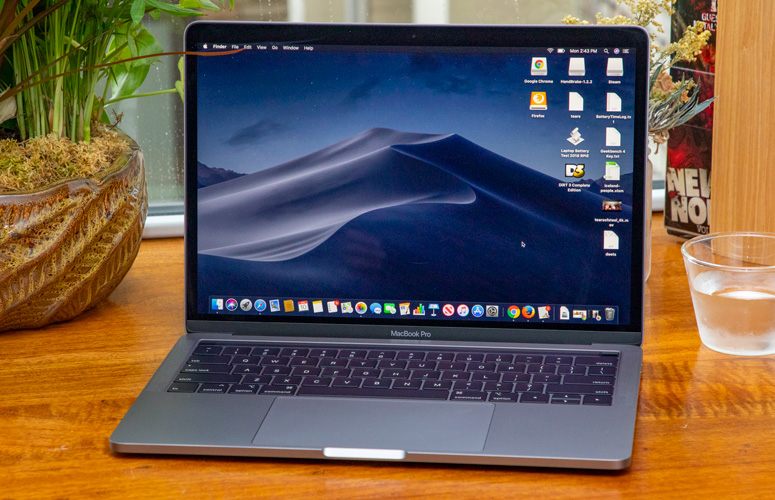
I've been using the updated 13-inch MacBook Pro for a week, and it remains one of the best performing laptops in its class. And while I didn't encounter any problems with the keyboard, it will take more time to determine whether Apple's design change will be enough to address the bulk of complaints. The battery life and design both remain good, but they could be better.
13-Inch MacBook Pro 2019 Price and Configuration Options
The 13-inch MacBook Pro with Touch Bar (released in August 2019) is still one of the most expensive 13-inch laptops out there. The MacBook Pro's price starts at a steep $1,799 with an 8th-Gen, 2.4-GHz Intel Core i5 processor, 8GB of RAM and 246GB of storage. We opted for 16GB of RAM (which I highly recommend for those who keep multiple apps and dozens of tabs open), which adds $200 to the price.
Other upgrades include a Core i7 CPU ($300) and several SSD options. Upgrading to 512GB costs $200, while 1TB ($600) and 2TB ($1,200) cost considerably more.
Design
Stop me if you've seen and heard this before. The 13-inch MacBook Pro with Touch Bar is a solid and elegant piece of aluminum available in Space Gray or Silver. But the look is getting stale at this point, as the bezels around the screen look pretty thick compared to the likes of the Dell XPS 13 and other Windows notebooks and 2-in-1 laptops.
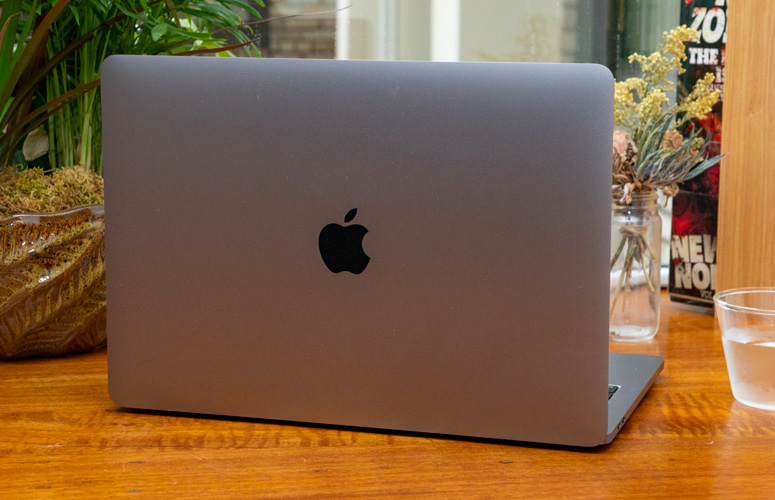
This MacBook Pro is fairly portable, at 3.02 pounds and 0.59 inches thick, but again, other Windows laptops are much sleeker. The XPS 13, for example, weighs 2.7 pounds and is 0.3 to 0.5 inches thick. The HP Spectre x360 is a bit lighter (2.9 pounds) and slimmer (0.5 inches) than the MacBook Pro, too, despite packing a touch screen.
Ports
One of the benefits of splurging for the Touch Bar model of the 13-inch MacBook Pro is that you get four Thunderbolt 3 ports (two on the left and two on the right).
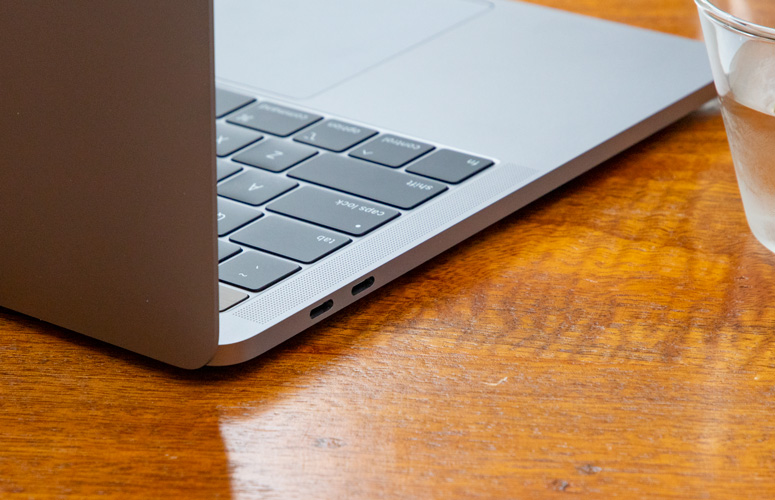
The non-Touch Bar MacBook Pro makes do with just two Thunderbolt 3 ports, on the left side. The headphone jack is on the right on this Touch Bar MacBook Pro.
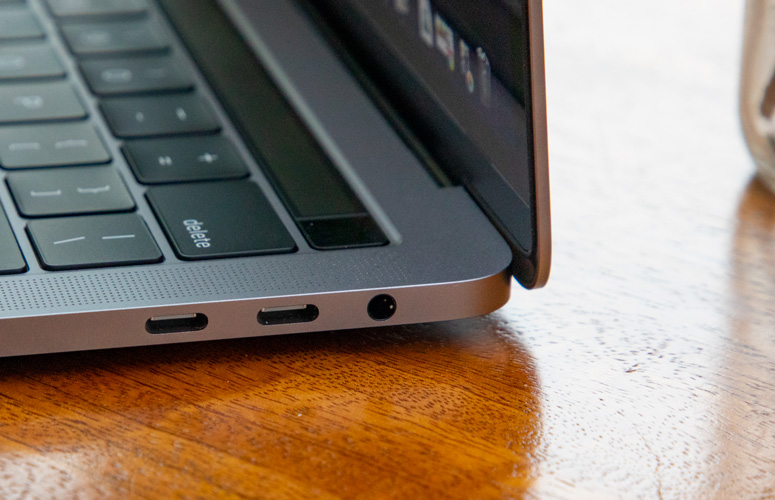
What's missing is any sort of memory card slot; the Dell XPS 13, HP Spectre x360 13-inch model and Lenovo Yoga C930 all squeeze in a microSD card reader. Plus, the HP and Lenovo include a full-size USB 3.1 port.
Keyboard
The bad news is that the latest version of Apple's butterfly keyboard on the 13-inch MacBook Pro offers the same shallow travel as previous editions. It's just 0.6mm, when we prefer 1mm or above for ultraportable laptops and Ultrabooks. The good news is that I typed quickly and comfortably on this laptop, as the actuation force of 60 grams provided enough feedback that typing didn't feel mushy.
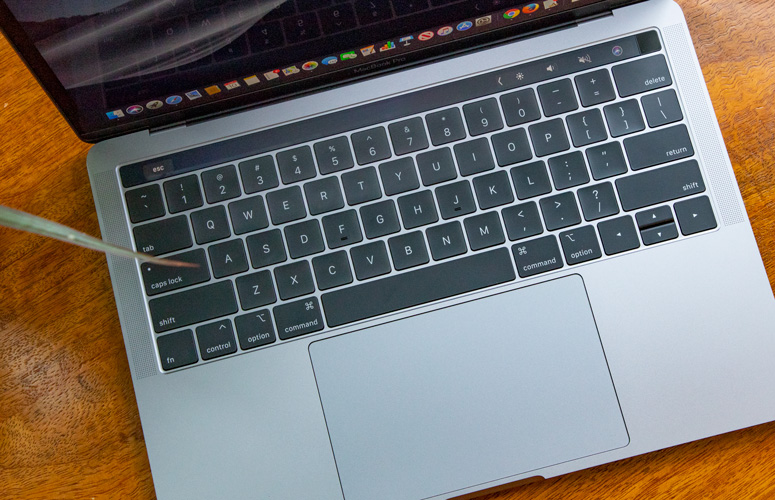
On the 10fastfingers.com typing test, I surpassed 77 words per minute with 95% accuracy. That's slightly faster than the 72 wpm I got on the 2018 MacBook Pro, but I achieved even better accuracy on that system, with 97.6%. On my everyday 2016 MacBook Pro without Touch Bar, I hit 75 wpm with 93.8% accuracy.
MORE: Apple's Pro Display Stand Costs a Grand, And Even Mac Fans Are ...
So, what about this new material on the keyboard, and what will it do? Apple isn't providing any details, other than to say that the changes should prevent issues like the double typing of letters or keys that fail to register. According to iFixit, which performed a tear down on the 15-inch MacBook Pro with the same design change, the switch cover now seems to be made of polyamide (aka, nylon) instead of polyacetylene, but the benefit to users of that change is not clear.
We plan on using this MacBook Pro for several weeks to see how the improved butterfly keyboard holds up.
Touchpad, Touch Bar and Touch ID
At 5.3 x 3.2 inches, the trackpad on the 13-inch MacBook Pro is as massive as ever, and it's just as responsive and accurate. Scrolling on this laptop is silky smooth, and it's a cinch to execute gestures like swiping up with three fingers for Mission Control or spreading three fingers to show the desktop.
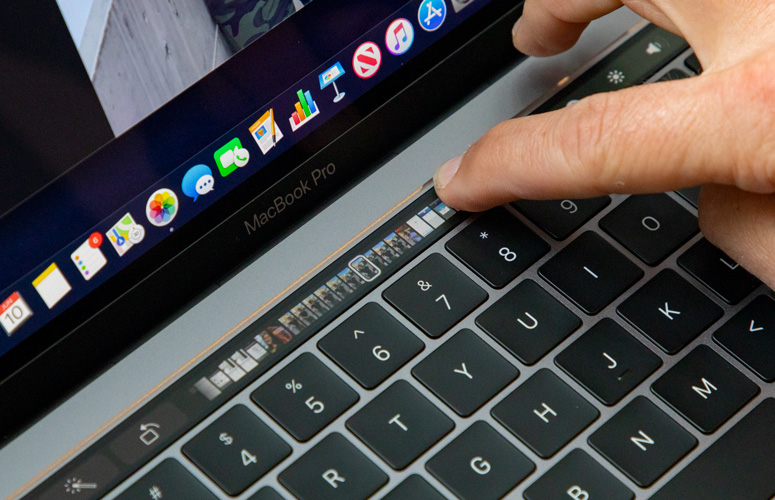
After debuting nearly three years ago, the Touch Bar on the MacBook Pro hasn't become as useful as I initially hoped -- and I was one of those people who said it was not a gimmick. The Touch Bar can come in handy when you're using some apps. For example, in Photos, this narrow secondary display lets you skim through photos just by sliding your finger. And in Safari, you can click on one of your favorite sites without looking at the main screen.
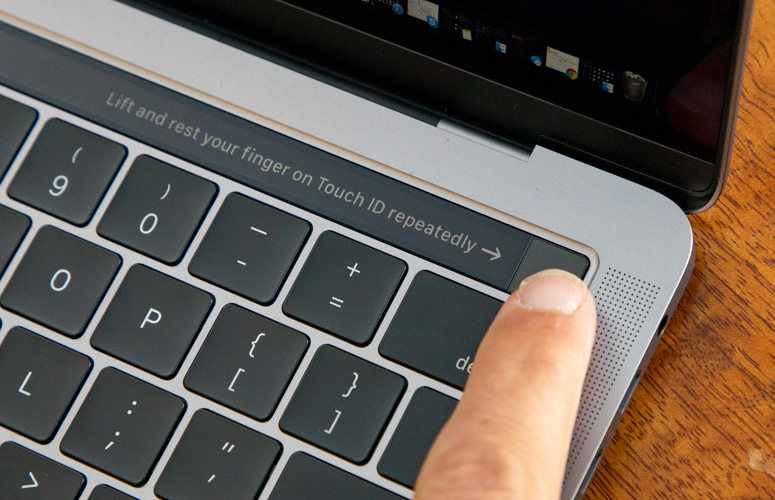
But the utility of this sliver of real estate pales in comparison to what Asus is doing with its larger ScreenPad and what you could do with a full-touch-screen, 2-in-1 laptop. The upcoming macOS Catalina lets you use an iPad as a secondary display with the Sidecar feature, but that's not the same as having a touchscreen baked in.
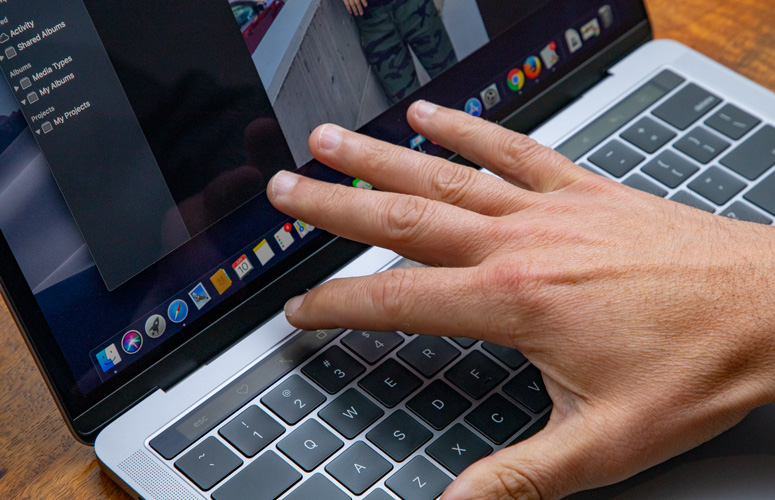
The 13-inch MacBook Pro does have a built-in Touch ID button, which doubles as a power button. This makes it easy to log in to your system with a simple press, though I'd like to see Apple add Touch ID to MacBooks to make things even faster. Still, it's nice that you can use Touch ID for Apple Pay and passwords on websites.
Display
Although I'd like to see Apple jump to 4K, it's hard to argue with the beauty of this 13-inch MacBook Pro's screen. The 2560 x 1600-pixel Retina display is bright, colorful and accurate. While watching the Star Wars: The Rise of Skywalker trailer, I could make out every fold in Rey's outfit and several wisps of her hair off to the right side. Her blue lightsaber beamed against the sandy backdrop as she flipped over an enemy ship speeding toward her.
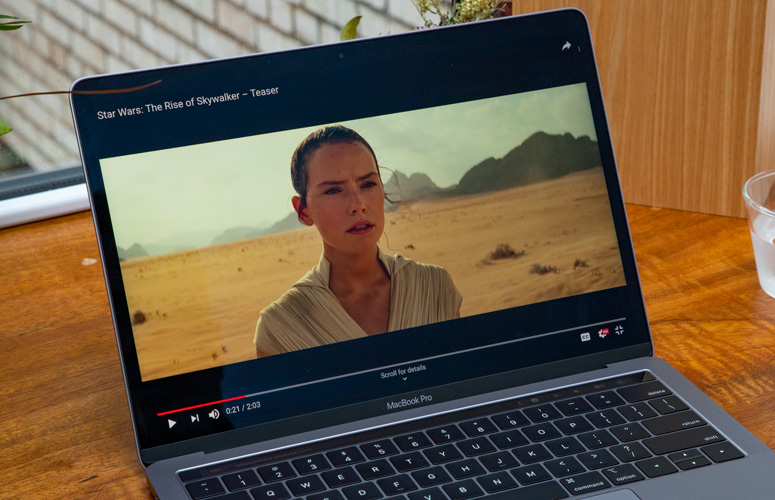
The panel itself also beamed in our lab tests, as it registered an average brightness of 408 nits. That soundly beats the HP Spectre x360 13-inch model (287 nits) and the Lenovo Yoga C930 (273 nits), and the MacBook's result also outshines the XPS 13's (375 nits).
MORE: Best MacBook - A Guide to Apple Laptops - Laptop Mag
The MacBook Pro's screen isn't the most colorful; it reproduced 118% of the sRGB color gamut in our tests, which is better than the Yoga C930's result (100%) but behind those from the XPS 13 (119%) and Spectre x360 (150%).
You won't find a display with more-accurate hues, though. The 13-inch MacBook Pro's panel turned in a Delta-E score of 0.12. A score of zero is perfect.
Audio and "Hey, Siri"
I would put the speakers on the 13-inch MacBook Pro up against those on any Windows laptop, and Apple would probably win. Not only is there a ton of power here -- "Night Running" from Cage the Elephant and Beck filled a large conference room with sound at 50% volume -- but there's also an impressive amount of bass here. I also appreciated the stereo separation on Twenty One Pilots' "Chlorine." The drum line was punchy but perfectly balanced with the slacker-melancholy vocals.
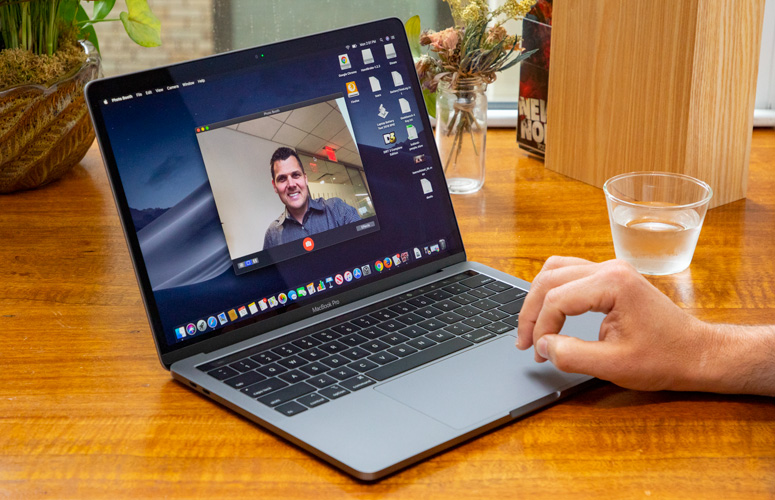
If you want to speak to the MacBook Pro, you can do just that with "Hey, Siri" support, which is enabled by the laptop's T2 chip. I could ask Siri to show me what my day looked like, which allowed me to see my appointments at a glance. Plus, I used the feature to open Photos and show pictures of just my dogs and open the browser to cnn.com. I also found it useful to switch to other apps with my voice, especially when I had too much open.
Performance
The 13-inch MacBook Pro with Touch Bar is easily one of the fastest laptops ever of its size. Our configuration packs a quad-core 8th-gen Intel Core i5 processor running at 2.4-GHz, 16GB of RAM and a 256GB SSD. I didn't see any lag even as I jumped between 17 tabs in Chrome while also running Skype, Slack and Pixelmator.
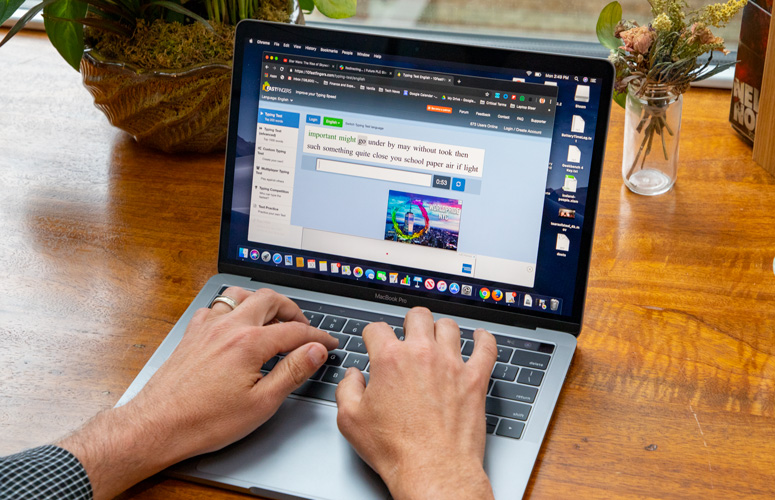
On Geekbench 4.1, which measures overall performance, the 13-inch MacBook scored a very high 18,221, which wipes the floor with the Dell XPS 13's mark of 14,936 (Core i7-8565U, 16GB of RAM) and the HP Spectre x360 13-inch model's score of 14,935 (Core i7-8565U, 8GB of RAM).
In our video-editing test, in which we transcode a 4K video file to 1080p, the MacBook Pro was a full 5 minutes faster than its closest competitor, the XPS 13, which needed 19:20 to complete the same tasks. Both the HP Spectre x360 13 and Yoga C930 took over 20 minutes.
MORE: 9 Demands for the MacBook Pro
The MacBook Pro's SSD continues to be off-the-charts fast. On the BlackMagic Disk Speed Test, this system turned in a write speed of 2,573 MBps. The Dell XPS 13 hit just 226.4 MBps on the same test, while the HP Spectre x360 13 hit 616.3 MBps.
You shouldn't expect the greatest graphics performance from this MacBook Pro, however. On low settings, it turned in a frame rate of 38 fps on the Dirt 3 racing game, while the XPS 13 hit 88 fps and the Spectre x350 reached 56 fps. The Yoga C930 was comparable to the MacBook Pro, at 37 fps.
Battery Life
Although Apple rates the 13-inch MacBook Pro for up to 10 hours of web surfing, we saw less endurance in our testing. Apple's laptop lasted for 8 hours and 41 minutes on the Laptop Mag battery test, which involves continuous web surfing over Wi-Fi at 150 nits of screen brightness. That's about the same runtime as last year's 13-inch MacBook Pro with Touch Bar and a Core i7 CPU (8:43).

This runtime beats the result from the XPS 13 with a 4K display (7:50), but the HP Spectre x360 13-inch lasted an epic 12:07 and the Lenovo Yoga C930 (10:10) also outlasted the MacBook Pro significantly.
Heat
Though it's one of the fastest 13-inch laptops ever, the MacBook Pro with Touch Bar kept its cool. After streaming video for 15 minutes, we measured temperatures of 84 degrees Fahrenheit on the touchpad, 90.5 degrees between the G and H keys, and 90.5 degrees on the bottom of the chassis. All of those temps fall below our comfort threshold.
macOS Catalina
Out of the box, the 2019 13-inch MacBook Pro with Touch Bar ran macOS Mojave, which includes welcome features like Dark Mode (which makes content easier on the eyes) and desktop Stacks (for better management of all your clutter).
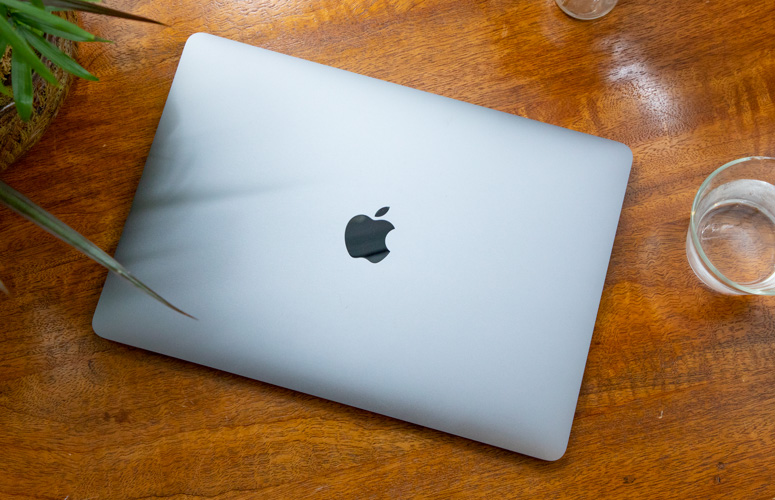
You can now upgrade to macOS Catalina for free. That update says goodbye to iTunes in favor of dedicated Music, Podcast and TV apps. And Project Catalyst brings more iPadOS apps to the Mac App Store, including quality games. Another big highlight is Sidecar, which allows iPad owners to use the tablet as a secondary display, complete with support for Apple Pencil.
MacBook comparison
If you're looking to save money, the 13-inch MacBook Air ($1,199) is a solid choice, as it delivers a lot of the same benefits as the 13-inch MacBook Pro, including a Retina Display, Touch ID and superfast SSD storage. The Air also lasts nearly an hour longer on a charge (9:32).
MORE: Apple Will Discontinue iPhone SE and iPhone X (Report)
However, the MacBook Pro with Touch Bar sports a full-power U-series processor, while the Y-series chip on the MacBook Air is slower. You also get a brighter screen on the MacBook Pro and more Thunderbolt 3 ports (four versus two), plus the improved keyboard. The Touch Bar can be nice to have, but I don't see it as a deciding factor.
To figure out which 13-inch MacBook is best for you, check out our MacBook Pro vs Air (2019) face-off.
Bottom Line
Overall, the 13-inch MacBook Pro is the Apple laptop I would buy for myself, even with its $1,799 starting price. It gives me all the power I could want, a brilliant display, great audio and an improved keyboard that should prove more reliable over time. I also continue to appreciate such amenities as Touch ID button and "Hey, Siri"
If you prefer Windows, you have plenty of great alternatives, such as Dell's XPS 13; it's lighter and thinner, with a better keyboard and a more aggressive price. Prefer a 2-in-1? HP's Spectre x360 13 boasts 3 hours more battery life than the MacBook Pro. But neither of these systems beats Apple on sheer performance.
I do wish Apple would debut a sleeker design with slimmer bezels and that the company could squeeze more battery life out of this platform. But overall, the 13-inch MacBook Pro with Touch Bar is a blazing-fast laptop for power users on the go.
Credit: Laptop Mag
MacBook Pro 13-inch with Touch Bar (2019) Specs
| Bluetooth | Bluetooth 5.0 |
| Brand | Apple |
| CPU | 2.4GHz quad-core Intel Core i5, Turbo Boost up to 4.1GHz, with 128MB of eDRAM |
| Company Website | https://www.apple.com |
| Display Size | 13 |
| Graphics Card | Intel Iris Plus Graphics 655 |
| Hard Drive Size | 256GB SSD |
| Highest Available Resolution | 2560 x 1600 |
| Operating System | macOS High Sierra |
| RAM | 8GB |
| RAM Upgradable to | 16GB |
| Size | 0.59 in x 11.97 in x 8.36 in |
| Touchpad Size | 5.3 x 3.2-inch |
| Weight | 3.02 pounds |
| Wi-Fi | 802.11ac |

